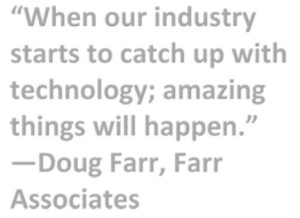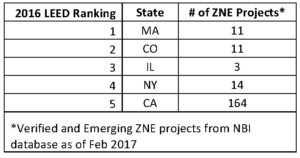Back in November, ComEd, Seventhwave and NBI hosted a Summit, focusing on the question: “What is Chicago’s path to net zero energy buildings?” Nearly 90 real estate professionals, designers and utility representatives gathered to focus on how they might build capacity for net zero energy buildings in the region.
In 2016, the USGBC ranked Illinois as #3 in the nation for LEED certified buildings, indicating a strong demand for efficient, green buildings and acknowledging the role that green building certifications can have on transforming the commercial real estate market. However, this success has not necessarily translated to a growth in net zero energy buildings the way we’ve seen in other top five states that appear on the USGBC list (see table below). Through a series of presentations and panel discussions from subject matter experts, the summit explored net zero trends at the national level, a variety of success stories, opportunities and challenges as well as practical tools and resources needed to advance the state of net zero projects.
George Malek from ComEd kicked things off by highlighting some of the ComEd’s recent programmatic successes in advancing energy efficiency in the Chicago region. After Ralph DiNola presented the national status of net zero buildings, Matt Edlen of Gerding Edlen used his keynote to sound a call to action for the green development. Through a series of examples he demonstrated the business advantages of high performance buildings highlighting the “Planet, People, Place” principle that have become a signature of so many Gerding Edlen projects.
The Summit featured several moderated panels with plenty of dialogue showcasing the wealth of experience gathered in the room as well as highlighting some of the key barriers that must be overcome in order to see the number of net zero projects grow across the region and state. Seventhwave captured the critical takeaways from these sessions including:
Private sector leadership and a dedicated team is essential. Achieving net zero energy is no easy task. There are no rules and defined steps for developers. However, the leaders of this movement will not let that get in their way. Channel your passion and innovate to make progress.
Baby steps are more easily attainable than huge leaps. Net zero is a journey. You can start where you are and improve over time. Even if net zero is not the goal, the process of examining every load on a building and trying to minimize that load can lead to substantial energy savings.
Triple bottom line business model is appealing. Both commercial and residential occupants see the benefits of deep green buildings as a reflection of their values. Here in the Midwest, energy costs are lower than other parts of the country. Cost savings cannot be the only reason to pursue net zero. Be sure to include quality construction, occupant health, happiness, and well-being in your conversations with customers.
Technical innovations are key but behavior cannot be ignored. Smart building technologies are necessary and extremely important. Every watt consumed in a building needs to be controlled. However, technology cannot do it alone. We need to implement simple behavior change strategies.
Use resources available and rethink the procurement process. From online tools, to technical assistance and incentives through the ComEd Energy Efficiency Program New Construction Service, there are many resources available today. Keep in mind—enforceable performance requirements, ongoing measurement, and continuous improvement are the keys to success.
For our part, NBI distilled our lessons from successful net zero buildings and provided two segments: Strategies for Getting to Zero and Integrating Net Zero into Your Practice. During these segments we articulated stepwise approaches to moving net zero building projects forward and empowering organizations to transition to developing net zero buildings as a part of their practice.
The Summit resulted in an important and successful first step to build the capacity for net zero energy buildings in the Chicago region, however there is still a lot to be done and NBI has spent much time formulating what key policy actions are needed to support progress. While Chicago can check several things on that key policy actions list, such as have as having a building disclosure policy as well as a supportive utility (ComEd), there remains a bit of a disconnect between the role that codes and policy play in helping to prime the market for net zero high performance buildings and what’s happening on the ground. Looking at other states that have excelled in moving the needle to net zero, there is typically a strong set of codes and policies in place that are helping chart a path. In order to more rapidly advance net zero buildings, leaders in Chicago and Illinois will have to make getting to zero a policy goal and define a roadmap to get there.

